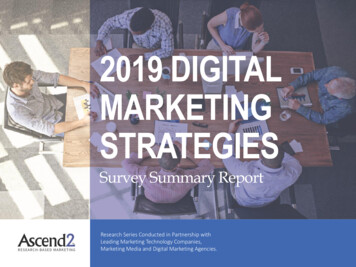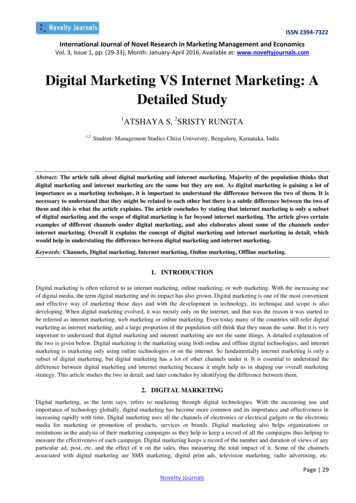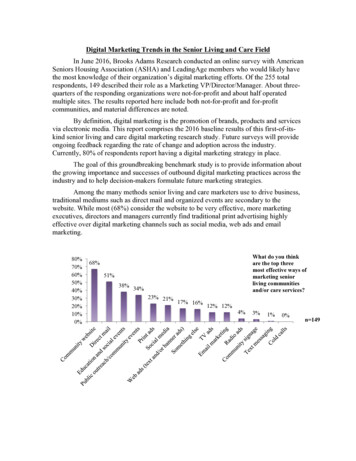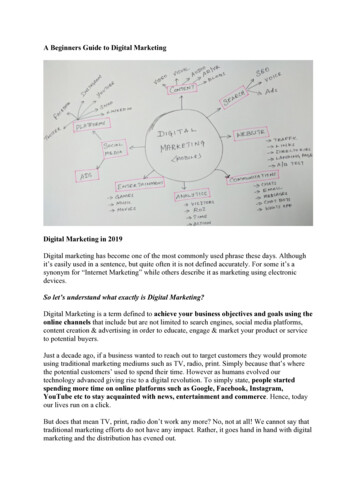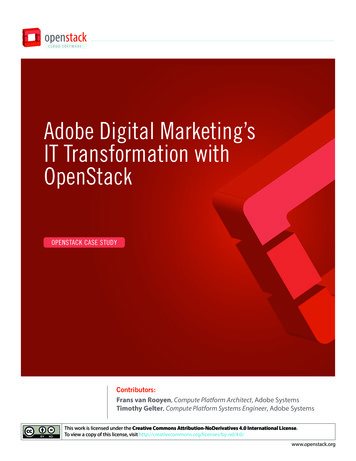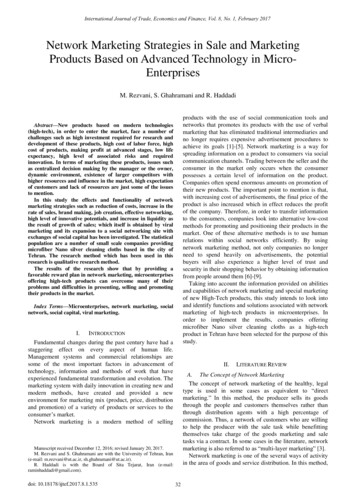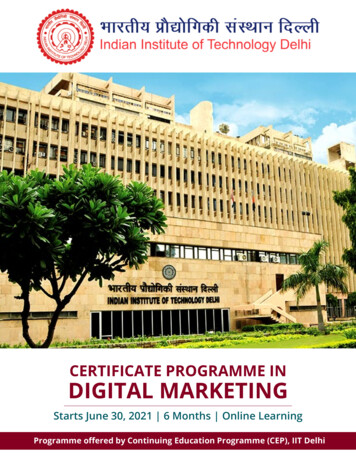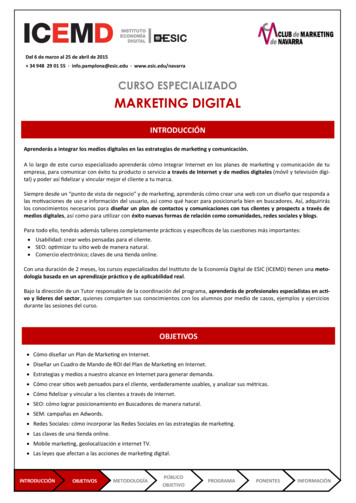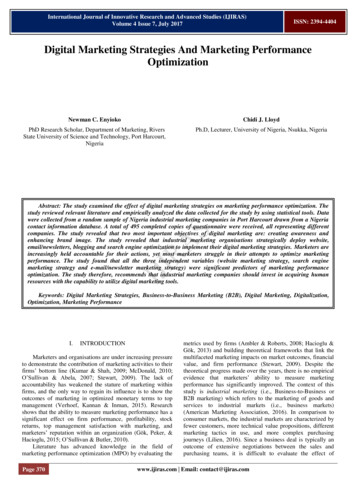
Transcription
International Journal of Innovative Research and Advanced Studies (IJIRAS)Volume 4 Issue 7, July 2017ISSN: 2394-4404Digital Marketing Strategies And Marketing PerformanceOptimizationNewman C. EnyiokoChidi J. LloydPhD Research Scholar, Department of Marketing, RiversState University of Science and Technology, Port Harcourt,NigeriaPh.D, Lecturer, University of Nigeria, Nsukka, NigeriaAbstract: The study examined the effect of digital marketing strategies on marketing performance optimization. Thestudy reviewed relevant literature and empirically analyzed the data collected for the study by using statistical tools. Datawere collected from a random sample of Nigeria industrial marketing companies in Port Harcourt drawn from a Nigeriacontact information database. A total of 495 completed copies of questionnaire were received, all representing differentcompanies. The study revealed that two most important objectives of digital marketing are: creating awareness andenhancing brand image. The study revealed that industrial marketing organisations strategically deploy website,email/newsletters, blogging and search engine optimization to implement their digital marketing strategies. Marketers areincreasingly held accountable for their actions, yet most marketers struggle in their attempts to optimize marketingperformance. The study found that all the three independent variables (website marketing strategy, search enginemarketing strategy and e-mail/newsletter marketing strategy) were significant predictors of marketing performanceoptimization. The study therefore, recommends that industrial marketing companies should invest in acquiring humanresources with the capability to utilize digital marketing tools.Keywords: Digital Marketing Strategies, Business-to-Business Marketing (B2B), Digital Marketing, Digitalization,Optimization, Marketing PerformanceI.INTRODUCTIONMarketers and organisations are under increasing pressureto demonstrate the contribution of marketing activities to theirfirms’ bottom line (Kumar & Shah, 2009; McDonald, 2010;O’Sullivan & Abela, 2007; Stewart, 2009). The lack ofaccountability has weakened the stature of marketing withinfirms, and the only way to regain its influence is to show theoutcomes of marketing in optimized monetary terms to topmanagement (Verhoef, Kannan & Inman, 2015). Researchshows that the ability to measure marketing performance has asignificant effect on firm performance, profitability, stockreturns, top management satisfaction with marketing, andmarketers’ reputation within an organization (Gök, Peker, &Hacioglu, 2015; O’Sullivan & Butler, 2010).Literature has advanced knowledge in the field ofmarketing performance optimization (MPO) by evaluating thePage 370metrics used by firms (Ambler & Roberts, 2008; Hacioglu &Gök, 2013) and building theoretical frameworks that link themultifaceted marketing impacts on market outcomes, financialvalue, and firm performance (Stewart, 2009). Despite thetheoretical progress made over the years, there is no empiricalevidence that marketers’ ability to measure marketingperformance has significantly improved. The context of thisstudy is industrial marketing (i.e., Business-to-Business orB2B marketing) which refers to the marketing of goods andservices to industrial markets (i.e., business markets)(American Marketing Association, 2016). In comparison toconsumer markets, the industrial markets are characterized byfewer customers, more technical value propositions, differentmarketing tactics in use, and more complex purchasingjourneys (Lilien, 2016). Since a business deal is typically anoutcome of extensive negotiations between the sales andpurchasing teams, it is difficult to evaluate the effect ofwww.ijiras.com Email: contact@ijiras.com
International Journal of Innovative Research and Advanced Studies (IJIRAS)Volume 4 Issue 7, July 2017marketing activities on the final purchasing decision andfinancial out-comes.Research shows that digitalization has significantlyreshaped industrial purchasing behaviourss. A total of 94percent of industrial buyers conduct online research beforepurchasing a product (Acquity Group, 2014) and completenearly 60% of typical purchasing process activities (e.g.,researching solutions, ranking options, benchmarking pricing)before contacting a seller (Adamson, Dixon, & Toman, 2012).Gillin and Schwartzman (2011) explain that industrial buyersrely on digital media in their purchasing journeys becausesearching solutions online is considered more efficient.From the industrial marketers’ point of view, the buyers’greater reliance on digital media provides new opportunities toincrease understanding of customers’ purchasing behavioursand measure the effects of digital marketing activities on thosebehaviours. Against this backdrop, the goal of this paper is toadvance our knowledge of the industrial marketers’ use ofdigital marketing strategies for optimizing marketingperformance in ways that create business benefits. In order toreach the purpose of the study, the paper attempts to achievethe following specific objectives: To determine the objectives and the usages of digitalmarketing instruments as well as their measurablebenefits To ascertain the relative importance of digital marketingtools. To find out whether industrial marketer’s efficientdeployment of digital strategies optimize digitalmarketing performance To identify the main digital marketing strategies andtactics used by industrial marketing organisations To identify the major challenges of digital marketingII. REVIEW OF RELEVANT LITERATUREA. CONCEPTUAL FRAMEWORKThe following sections review the literature related to theconceptual framework of this paper (Figure 1). ptimization.Figure 2: Conceptual Frameworks of the paper: DigitalMarketing Strategies and Marketing PerformanceOptimizationThe conceptual framework integrates multiple theoreticalstreams under a unified model. The framework starts with thewidely-accepted notion that digitalization has caused majorchanges in customer behaviour with respect to mediaconsumption habits, communications patterns, and purchasingjourneys (Kumar & Salo, 2016; Hoffman, & Spann, 2013).These changes have encouraged marketers to change theirstrategies and tactics (Hemani, 2015). They have alsoprovided new opportunities to collect data on customerbehaviour and marketing performance optimization throughthe use of digital marketing strategies (Chaffey & Smith,2013).B. EFFECTS OF DIGITALIZATION ON CUSTOMERBEHAVIOURAdvances in information technology (IT) and theemergence of new innovations have changed customerbehaviour and marketing practices. Some of the most radicalinnovations enabled by IT include the Internet, World WideWeb, web-sites, search engines, email platforms, social mediaplatforms, and mobile de-vices. These innovations haveincreased the volume and accessibility of digital informationby making it ubiquitous (i.e., information can be accessed anywhere at any time), and have fostered the fast and smoothexchange of information between people and organizations viadigital communication channels (Leeflang, Verhoef,Dahlström, & Freundt, 2014; You, Vadakkepatt, & Joshi,2015). As a result, customer behaviour has radically changedin terms of media consumption habits, communicationspatterns, and purchasing journeys: Increased consumption of digital media Increased fragmentation of media consumption Media multiplexing Customers have become active participants in themarketing communications process (many-to-manymodel) Growing reach and influence of eWOM Purchasing journeys have be-come non-linear andunsystematicDigital media plays an increasing role in various phasesof the purchasing processa.Source: Review of Relevant Literature by the Researcher,(2017)Page 371ISSN: 2394-4404CONCEPT OF DIGITAL MARKETINGAs at date of this paper (March 4th, 2017), the search term“digital marketing” returns roughly 22,751 results in GoogleScholar (Sullivan, 2017). In comparison, the search term“definition of digital marketing” returns just 47 results and“digital marketing definition” returns only eleven. Thesenumbers illustrate that there is a growing body of academicliterature on digital marketing, yet very few studies haveexplicitly de-fined what is meant by the term. In most studies,the meaning of digital marketing is implicitly described interms of certain marketing tactics and technologies orcharacteristics of the digital environment, but thesedescriptions tend to be vague and varied, with each providingwww.ijiras.com Email: contact@ijiras.com
International Journal of Innovative Research and Advanced Studies (IJIRAS)Volume 4 Issue 7, July 2017a slightly different perspective on digital marketing. Eventhose studies that explicitly provide a definition for digitalmarketing tend to refer to commercial sources (Royle &Laing, 2014; Zahay, 2014).The Digital Marketing Institute defines digital marketingas “the use of digital technologies to create an integrated,targeted and measurable communication which helps toacquire and retain customers while building deeperrelationships with them” (Smith, 2007). This definition suitsthe agenda of this paper particularly well as it emphasizesmeasurable communications through the use of digitaltechnologies. It indicates that technologies are not only usedas platforms or channels for delivering digital marketingactivities, but are also applied for crafting, targeting, andmeasuring those activities.The selection of the term digital marketing for thepurposes of this paper is based on its broad conceptualization,which includes the planning, implementation, andmeasurement of marketing via technology. The selection isfurther justified by evidence showing how the use of the termdigital marketing has grown rapidly over recent years. Figure2 illustrates the relative volume of Google search terms:“digital marketing,” “interactive marketing,” “Internetmarketing,” and “e-marketing.” The graph reveals that thevolume of searches on digital marketing exceeded the othercompeting search terms in 2013 and has become by far themost popular search term in 2016. This evidence providessupport for the terminological shift toward digital marketing.Source: Sullivan, D. (2017). Google Still Doing At Least 1Trillion Searches Per YearFigure 2: The relative volume of Google search terms: digitalmarketing, e-marketing, interactive marketing, and Internetmarketing(Online) retrieved from s-per-year 212940 [Accessed on 12thMarch, 2017].b.number of firm-specific marketing objectives, but the ultimatemarketing goal is to generate positive cash flow and net profit(Ambler & Roberts, 2008).Digital marketing strategy pertains to the means by whichdigital marketing goals are attained (Li, Li, He, Ward, &Davies, 2011). Put another way, while digital marketing goalsdescribe where a company wants to be, the digital marketingstrategy articulates how it gets there (Chaffey & Smith, 2013,p. 3). Research shows that aligning a firm’s marketing strategywith its business strategy leads to superior performance interms of profitability and market performance. Consequently,a marketing strategy must be firm-specific because it issubordinate to the selected business strategy.c.DIGITALTACTICSPage 372MARKETINGSTRATEGIESANDThe digital environment has created new opportunities forcompanies to achieve marketing goals and execute strategiesthrough various activities. Companies spend an average of10.2% of their annual revenue on marketing activities, andapproximately one-quarter of their total marketing expenditureis spent on digital marketing activities (Gartner, 2014).Academic research on the effectiveness of digital marketingstrategies has concentrated on the B2C context and the use offour specific tactics: company websites (Toufaily, Ricard, &Perrien, 2013), display advertising (Hoban & Bucklin, 2015),search engine advertising (Chaffey & Smith, 2013), and emailmarketing (Kumar & Salo, 2016).According to the State of Digital Marketing report(Webmarketing123, 2015), email marketing is the mostcommonly used strategy/tactic for industrial companies, whilemarketing via SNSs is the most widely adopted consumermarketing strategy/tactic. Within SNSs, Facebook isconsidered the most important social channel by B2Ccompanies, whereas LinkedIn is the primary channel forindustrial firms. Table 1 lists some of the most widely useddigital marketing iptionA company website is usually the home base for afirm’s digital presence. It is used for multiplepurposes, such as providing firm-related informationto customers, building brand image, and fosteringdirect and indirect sales (Chaffey & Smith, 2013).Display/banneradvertisingHyperlinked pixel displays on websites, which areused for gaining visibility, generating traffic for thecorporate website, and building brands (Kumar &Salo, 2016).A form of advertising where firms pay fees to searchengines (e.g., Google, Bing, Yahoo!) to be displayedin search results with specified keywords. The goal isto drive the targeted audience to the company websiteor other firm-related media space (e.g., a firm’sLinkedIn page) (Hoban & Bucklin, 2015).SearchengineadvertisingDIGITAL MARKETING GOALS AND STRATEGICTRENDSDigital marketing strategies, tactics, and performanceoptimization should be based on marketing goals (Gök, Peker,& Hacioglu, 2015). A company may have tactical objectivesspecifically tailored to digital marketing, such as websitetraffic growth and an increase in sales leads sourced fromdigital channels; however, the strategic goals of marketingtypically converge across channels, and thus digital mediasimply provides new ways to achieve them. There can be aISSN: 2394-4404SearchengineoptimizationA process of identifying and fine-tuning the elementsand content of a website to achieve a high ranking torelevant queries in search result listings, andsubsequently attract the targeted audience (Gök,Peker, & Hacioglu, 2015).Emailmarketing/newslettersElectronic mail for reaching potential and existingcustomers with tar-geted marketing messages(Toufaily, Ricard, & Perrien, 2013).www.ijiras.com Email: contact@ijiras.com
International Journal of Innovative Research and Advanced Studies (IJIRAS)Volume 4 Issue 7, July 2017AffiliatemarketingBloggingMarketingthrough socialnetworkingservices (SNSs)MobileapplicationsThe contractual placement of hyperlinks on thirdparty websites (i.e., affiliate sites), which are aimedat drawing visitors to the company web-site as aresult of clicking on the hyperlinks (Li, Li, He, Ward,& Davies, 2011).Examples of affiliate marketing are the inclusion ofcompany products on price comparison sites orspecial rebate sites and banner ads on affiliatewebsites.A company blog (i.e., a Web log) is a website or asection on a company website where companyrepresentatives or invited writers provideperspectives on topical issues related to the companyor industry. A blog consists of blog posts presented inreverse chronological order that may include text,graphics, videos, and/or links to other web pages(Kumar & Salo, 2016).Companies may build their own profiles on SNSs(e.g., Facebook, LinkedIn, Google , Instagram,Pinterest) through which they can inter-act with theircustomers (Chaffey & Smith, 2013), post content(i.e., text, pictures, videos) and advertise totargeted audiences(Zahay, 2014).Branded software downloadable to mobile devicesthat are primarily used for engaging customers tointeract with the company and for creating favorableattitudes among customers (Hemani, 2015).Webinars&webcastsWebinars (i.e., Web-based seminars) are interactivelive presentations transmitted online (Hemani, 2015).Webinars are typically hosted by experts and theirpurpose is to educate potential and existing customersabout a specific business- or industry-related issue.The difference between webinars and webcasts is thatwebcasts are recorded presentations and thus do notallow participants to interact with the presenter inreal time.DigitalcommunitiesDigital communities (i.e., online/electronic/virtualcommunities) are aggregations of individuals orbusiness partners who interact based on a sharedinterest (Hoban & Bucklin, 2015). Marketers canbuild theirown brand communities (e.g., SAP CommunityNetwork and Oracle Technology Network) todevelop customer relationships and foster customerengagement or participate in content communitiesinitiated by community members themselves or thirdparty companies (e.g., YouTube, Wikipedia andLinkedIn groups) where firms can contribute to brandbuilding and have influence on other communitymembers (Hemani, 2015).Digitalmarket-placesand auctionsDigital marketplaces (i.e., electronic or emarketplaces) in the industrial context refer to thirdparty websites or platforms where a number ofvendors and customers can interact and conductbusiness transactions (You, Vadakkepatt, & Joshi,2015). Sellers can use them to acquire newCustomers and increase efficiency by streamliningthe selling processes (Gök, Peker, & Hacioglu, 2015).Digital auctions are a special type of an emarketplace where buyers bid for a certain product orvice versa, sellers bid to win a specific business dealposted by a customer (Hoban & Bucklin, 2015).Table 1: Digital marketing Strategies and TacticsThese differing usage patterns suggest that the perceivedeffectiveness of specific digital marketing activities variesbetween industrial and B2C companies. A few studies havePage 373ISSN: 2394-4404examined the relative effectiveness of digital marketing tacticson producing sales in B2C settings (Kumar & Salo, 2016; Li& Kannan, 2014).C. MARKETING(MPO)PERFORMANCEOPTIMIZATIONMarketing performance optimization is an integral part ofthe media mix and serves both customer acquisition andcustomer retention; objectives of the company using e-mailmarketing, affiliate marketing, retargeting or search enginemarketing. The instruments always pursue the objective ofidentifying measurable customer responses (Zahay, 2014).Gök, Peker, & Hacioglu, (2015) maintain that whencompanies know their customers’ requirements, they caneasily address them and adjust their strategy accordingly –which is actually most important, considering that theoptimization of different advertising strategies are the nuts andbolts of performance marketing.Frösén, Luoma, Jaakkola, Tikkanen & Aspara (2016)insist that the marketer should just make sure that activities areanalyzed for each channel, so that interfaces can be createdthat increase the effectiveness of the campaign, and take alook at the following checklist in case the organization wantsto revise its marketing performance: Test everything before you make any decisions Check the customer journey: Analyze the surfing habits of your customers Go for multi-channel Increase the effectiveness of your campaign with realtime tracking Use retargeting for directly measurable resultsAccording to the definition proposed by Morgan et al.(2002), efficiency refers to productivity (i.e., marketing inputsand outputs ratio), effectiveness indicates the extent to whichmarketing goals and objectives are met, and adaptivenessinvolves the organizational ability to react to changes in afirm’s environment. Distinguishing between these dimensionsis important because some marketing activities may, forinstance, be efficient but not effective. As an example: Anemail campaign can be efficient in the sense that it maygenerate sales revenue with limited cost, as emails aretypically cheap to produce and deliver to customers; however,should customers become irritated by the emails, the campaigncould ultimately become ineffective with regard to the firm’sobjective of improving customer loyalty. In such a case,marketers should be adaptive and attempt to seek moreinnovative ways of addressing customers via, for example,social media marketing.D. CHALLENGES OF DIGITAL MARKETINGA notable number of digital marketing initiatives fail toreach their objectives and deliver the benefits expected ofthem (Li & Kannan, 2014). As the emergence of new digitaltools accelerates, it is no wonder that B2B firms need time tocomprehend which tools are apt for their industries and howthey might best be utilized for marketing purposes. Forinstance, Zahay (2014) reports that a large portion of B2Bfirms views the use of social networking sites as irrelevant towww.ijiras.com Email: contact@ijiras.com
International Journal of Innovative Research and Advanced Studies (IJIRAS)Volume 4 Issue 7, July 2017the firm’s particular industry. This finding indicates that thebenefits derived from at least a part of the mainstream socialmedia tools in the B2C sector are still unclear to various B2Bfirms. In particular, the difficulty of determining return oninvestment (ROI) has been noted as one of the majorchallenges to investing in digital marketing (Zahay, 2014).Another issue closely related to obscure benefits derives fromthe perceived risks. In particular, the lack of control ofmarketing messages and their distribution is considered amajor risk when using social media tools as part of the digitalmarketing mix (Hoffman, & Spann, 2013).In addition to the risks arising from lack of control of thesocial media environment, companies might perceive risksconnected to the expertise they have available to harness thenew digital tools for marketing. As technology developsquickly, it is evident that many employees will have difficultykeeping pace with it. In fact, research has shown that onesignificant barrier to technology adoption is a lack of generaltechnical knowledge and personal innovativeness amongpersonnel (Kumar & Salo, 2016). As the use of social mediatools, such as blogs, open discussion forums, and socialnetworking sites, requires new kinds of conversationalapproaches rather than one-directional marketing messages(Hoffman, & Spann, 2013), it therefore follows thatcompanies from various industries are likely to encountersevere challenges in their ability to create proper content forsocial media. Judging from the wide range of challenges ofdigital marketing and technology use encountered by firms,the study expects to find several important challenges thathinder the use of digital marketing in the B2B sector.A. BARRIERS TOMARKETINGTHEUSAGEOFDIGITALWhen employees have limited capability to use digitaland social media tools, the role of management is emphasized.Indeed, the lack of technical or management support has beenhighlighted as an important barrier to usage in several studies(O’Sullivan & Butler, 2010). Managers need to set accurateexpectations with regard to the use of a particular technology(Ambler & Roberts, 2008) and clarify the responsibilities ofeach individual user to reduce role overload and. The roleoverload and stress are further increased if the employees arenot provided with adequate resources; research has indicatedthat the major challenges to technology use stem from a lackof resources (e.g., time, money, and workforce) to fullyexploit the new technology (Gök, Peker, & Hacioglu, 2015).III. METHODOLOGYSurvey design involving the use of a structuredquestionnaire to elicit data from the respondents was used.Data were collected from a random sample of Nigeria B2Bcompanies in Port Harcourt drawn from a Nigeria contactinformation database. A link to the online survey was sent viae-mail to the general manager or marketing director of eachB2B firm in the sample. A total of 495 completed copies ofquestionnaire were received, all representing differentcompanies. Data were analysed by using descriptive andPage 374ISSN: 2394-4404inferential statistics. The study conducted a structural equationmodeling using SPSS 17.0 software to test the hypotheses.IV. RESULTS AND ANALYSISResearch Question 1: What are the main objectives ofdigital marketing?MeanAllCreating awarenessEnhancing brand imageGrowing sales/newcustomersImproving customerserviceEnhancing customerloyaltyImproving customersatisfactionGrowing sales/existingcustomersDecreasing costsMicro Small Medium Large sig.4.154.123.963.834.144.174.304.334.42 .1674.42 .0543.823.704.063.673.88 .4703.813.833.584.003.92 .4123.783.703.753.734.04 .6463.773.763.643.973.79 .6323.573.463.353.303.753.313.373.704.00 .0813.71 .242Source: Survey Data, 2017Note: Scale ranging from 1 not at all important to5 extremely importantTable 1: The Main Objectives of Digital MarketingIn line with the first objective of the study two mostimportant ideas of digital marketing in the era of social mediaare related to the soft side of marketing: creating awarenessand enhancing brand image (table 1). Both objectives receiveda mean score of above 4.1 on a scale ranging from 1 (not at allimportant) to 5 (extremely important). Specifically, over 75%of the respondents regarded creating awareness and enhancingbrand image as “important” or “extremely important.” Thus,the first objective of the study is achieved. The first objectivetries to determine the objectives and the usage of digitalmarketing and their measurable benefits.RESEARCH QUESTION 2: WHAT IS THE RELATIVEIMPORTANCE OF DIGITAL MARKETING TOOLS?Media Tools by Firm SizeNewsletters and e-mailmarketingSales support materials(e.g., white papers,digitalproduct brochure)E-mail/SMS servicealerts and notificationsDigital customermagazineYouTube (or other .561.772.37.000Open discussion s, podcasts andlive castsTwitterFlickr (or other 2.29.091.000www.ijiras.com Email: contact@ijiras.com
International Journal of Innovative Research and Advanced Studies (IJIRAS)Volume 4 Issue 7, July 2017Source: Survey Data, 2017Note: Scale ranging from 1 not at all important to5 extremely importantTable 2: The Perceived Importance of Digital Marketing andSocialIn line with the second objective of the study, table 2shows that the most important digital marketing tools for B2Bcompanies remain newsletters and e-mail marketing. Thefindings further suggest, irrespective of firm size, that the useof other long-established digital marketing tools, such as salessupport materials, e -mail and SMS service alerts andnotifications, and digital customer magazines, are perceived tobe more important than social media tools. The study’s secondobjective seeks to ascertain the relative importance of digitalmarketing tools., that social media tools are more importantfor large-sized B2B companies, is also supported. Largercompanies perceive YouTube, blogs, webinars, Twitter, andWikis, in particular, to be more important than SMEs do.RESEARCH QUESTION 3: HOW DOES INDUSTRIALMARKETER’S EFFICIENT DEPLOYMENT OF DIGITALSTRATEGIES OPTIMIZE DIGITAL MARKETINGPERFORMANCE?OptionsNumber of theRespondentsPercentage/ResponseVery high13427%performanceHigh performance11924%Moderate9920%performanceLow performance8417%Very low5912%performanceTotal495100%Source: Survey Data, 2017Table 4: industrial marketer’s efficient deployment of digitalstrategies/analytics and optimization of digital marketingperformanceTable 4 shows how industrial marketer’s efficientdeployment of digital strategies optimizes digital marketingperformance in line with objective four of the study. From thedata, it is revealed that 27% of the respondents indicated thatindustrial marketer’s efficient deployment of digital strategiesoptimizes digital marketing to very high performance. Also,24% of the respondents indicated industrial marketer’sefficient deployment of digital strategies optimizes digitalmarketing to high performance while 20% of the respondentsindicated that industrial marketer’s efficient deployment ofdigital strategies optimizes digital marketing to moderateperformance. Equally, 17% of the respondents indicated thatindustrial marketer’s efficient deployment of digital strategiesoptimizes digital marketing to low performance. Only 12% ofthe respondents indicated industrial marketer’s efficientdeployment of digital strategies optimizes digital marketing tovery low performance. The items in table 4 have helped inachieving objective four of the studyPage 375ISSN: 2394-4404RESEARCH QUESTION 4: WHAT ARE THE MAINDIGITAL MARKETING STRATEGIES AND talMarketingStrategiesScalingDimensionsWebinars gSearch rough socialnetwork servicesViral marketingDigital marketplacementauctionsMobileapplicationDigital marketing strategies Totalused by Industrial MarketersSD 1MeanRankingDUA SA 2 3 4 575162 270 240 285 10322.825th6078189 360 555 12423.392nd30102 135 312 795 13743.761st70170 240 340 275 10952.994th101178 138 248 510 11753.213rd120144 279 192 1508852.429th144114 261 132 2108612.3510th4178140 135 356 280102 144 244 4059529732.602.668th7th23142 106 212 4159972.726thSource: Survey Data, 2017Decision Points 1.49 Strongly Disagree; 1.50 -2.49 Disagree; 2.50- 3.49 Undecided; 3.50 – 4.49 Agree; 4.50 strongly agreeTable 3: Ranking of the Digital Marketing Strategies Used byIndustrial Marketing OrganisationsTable 3 shows the ranking of the digital marketingstrategies deployed by industrial marketers in line with thefourth objective of the study. The data reveal that "websitemarketing" is the 1st digital marketing strategic tool deployedby industrial marketers as this option garnered 1374 points anda mean score of 3.76 as indicate by the respondents followedin that order as the 2nd digital marketing strategic tooldeployed by industrial marketers is “email marketing/newsletters’ because the option garn
marketing goal is to generate positive cash flow and net profit (Ambler & Roberts, 2008). Digital marketing strategy pertains to the means by which digital marketing goals are attained (Li, Li, He, Ward, & Davies, 2011). Put another way, while digital marketing goals describe where a company wants to be, the digital marketing
